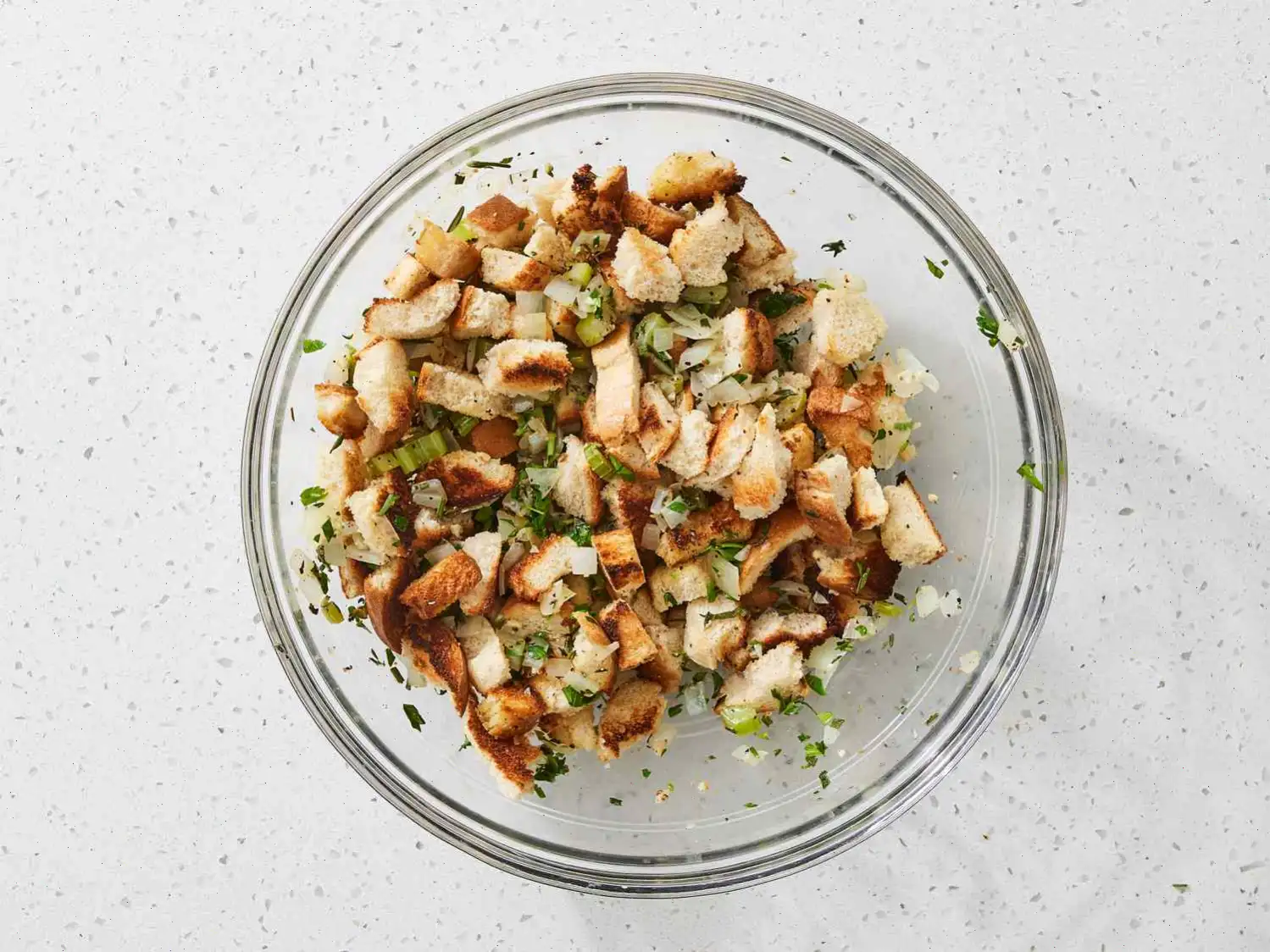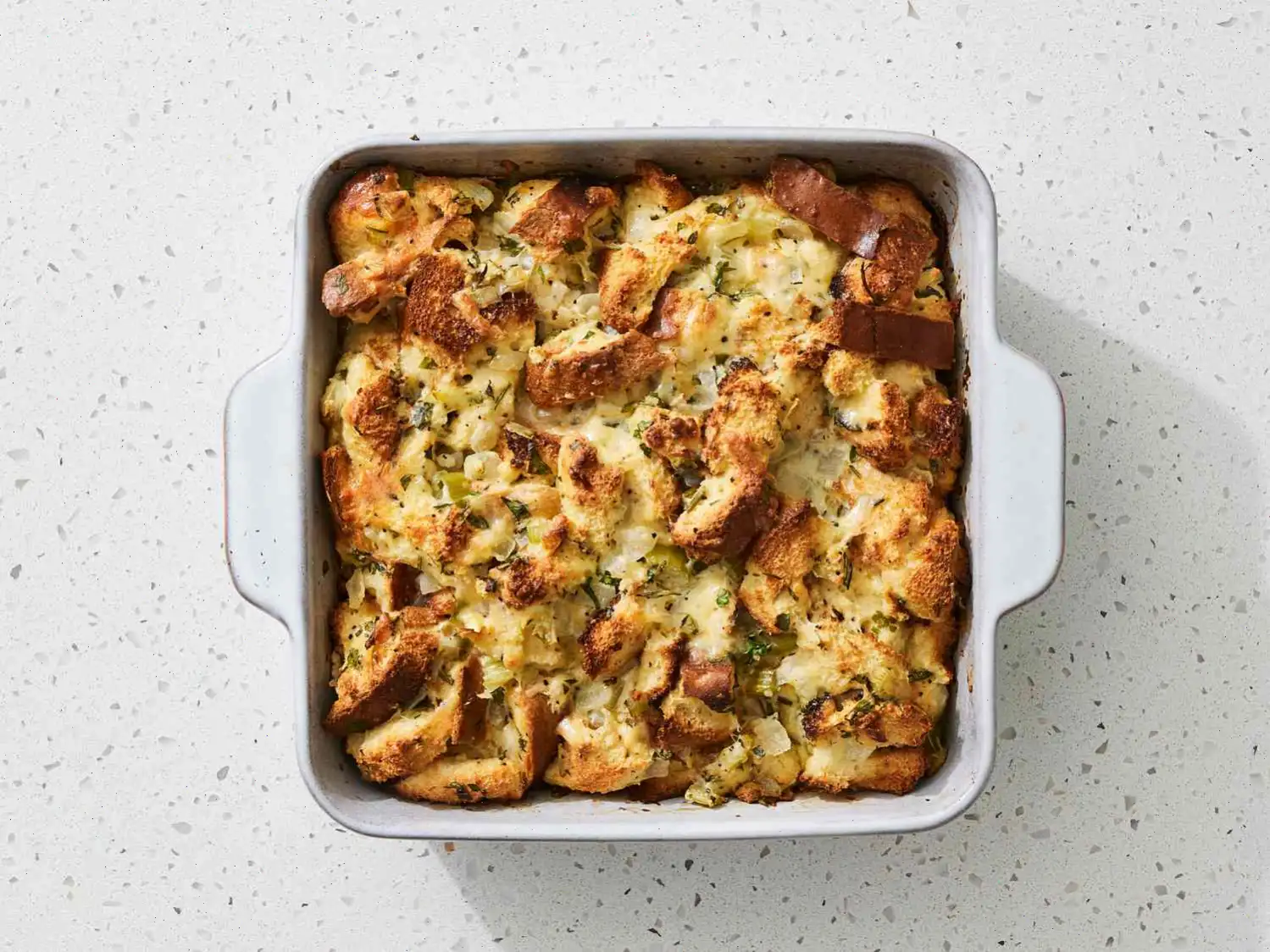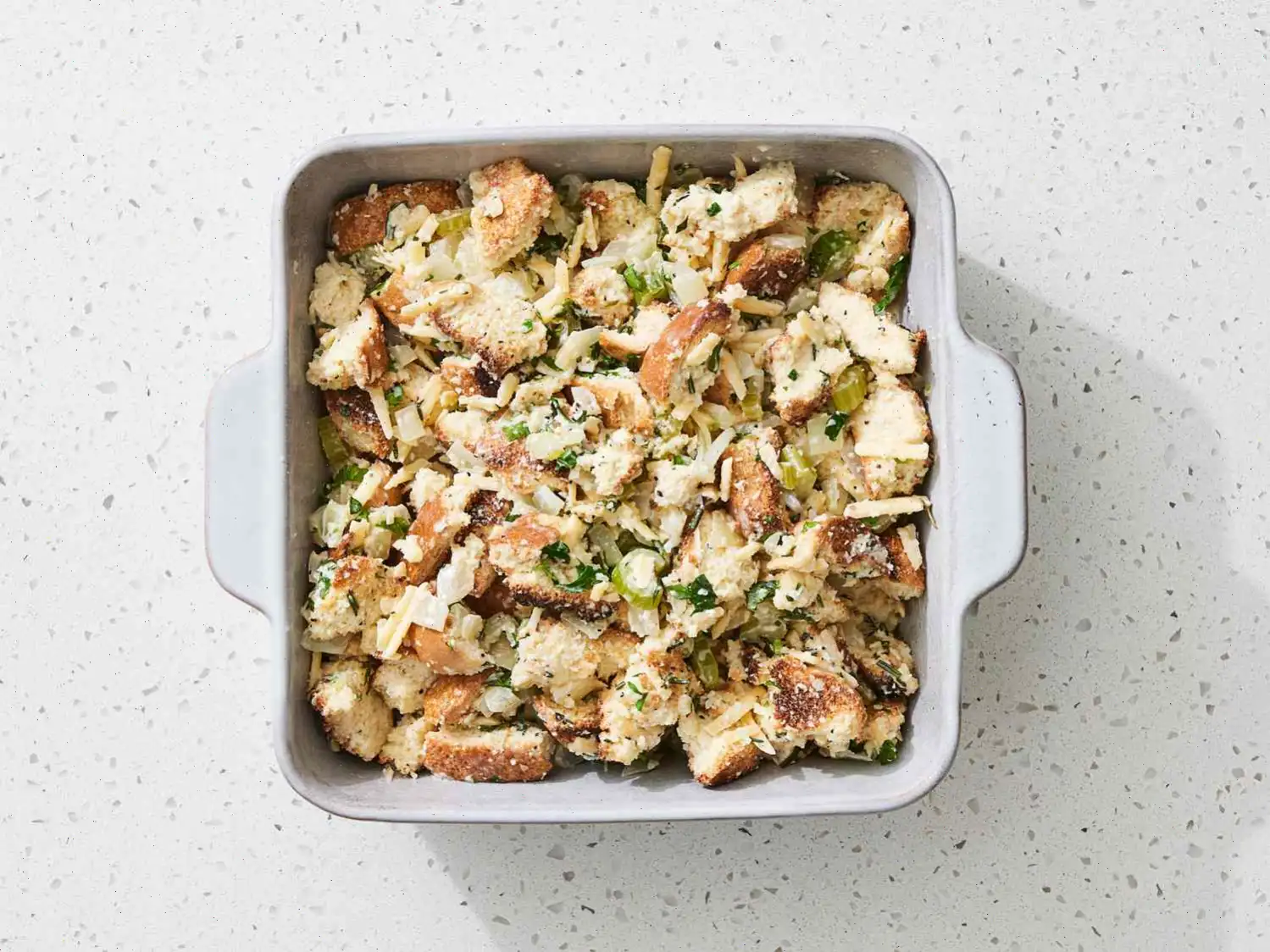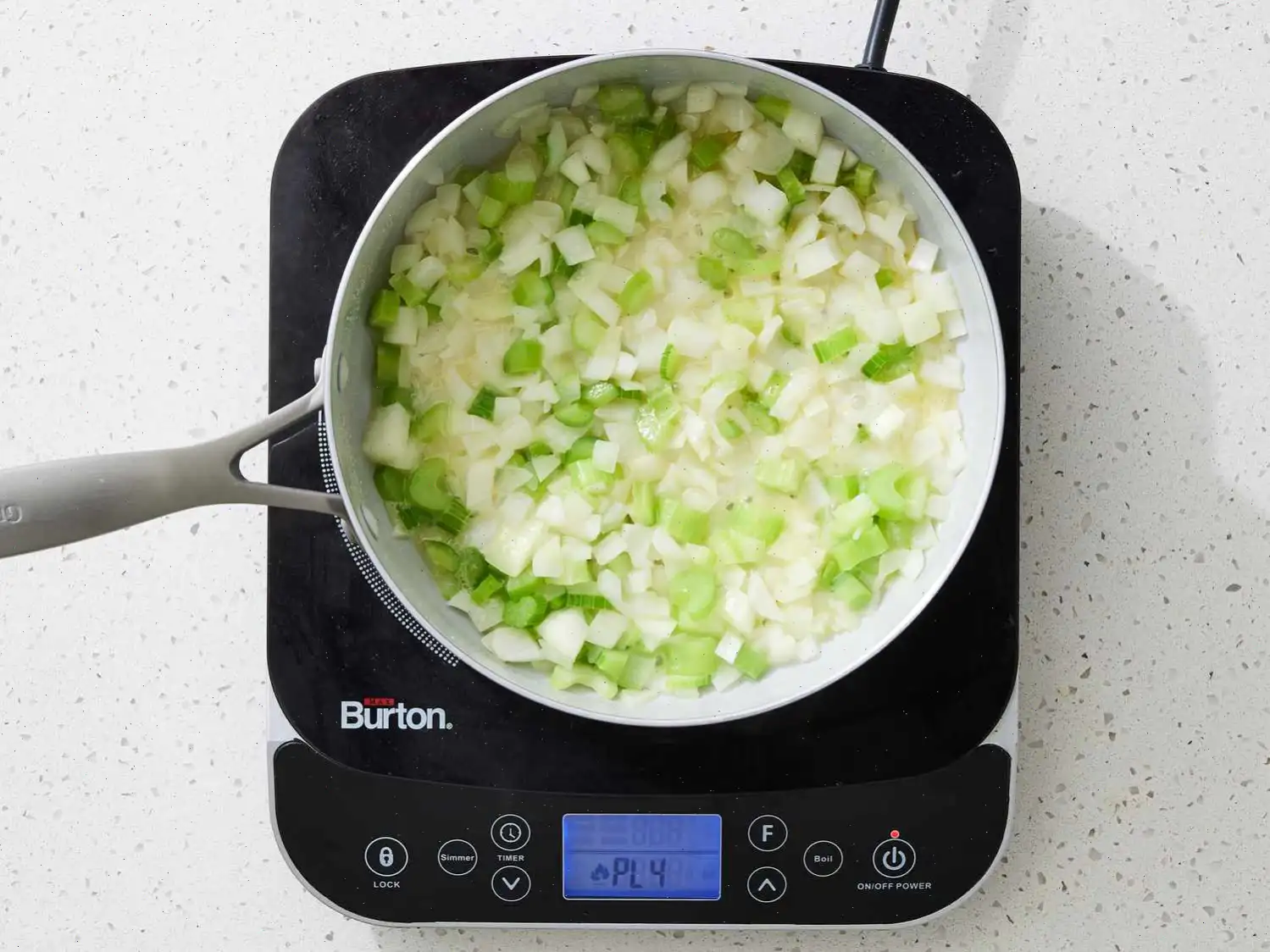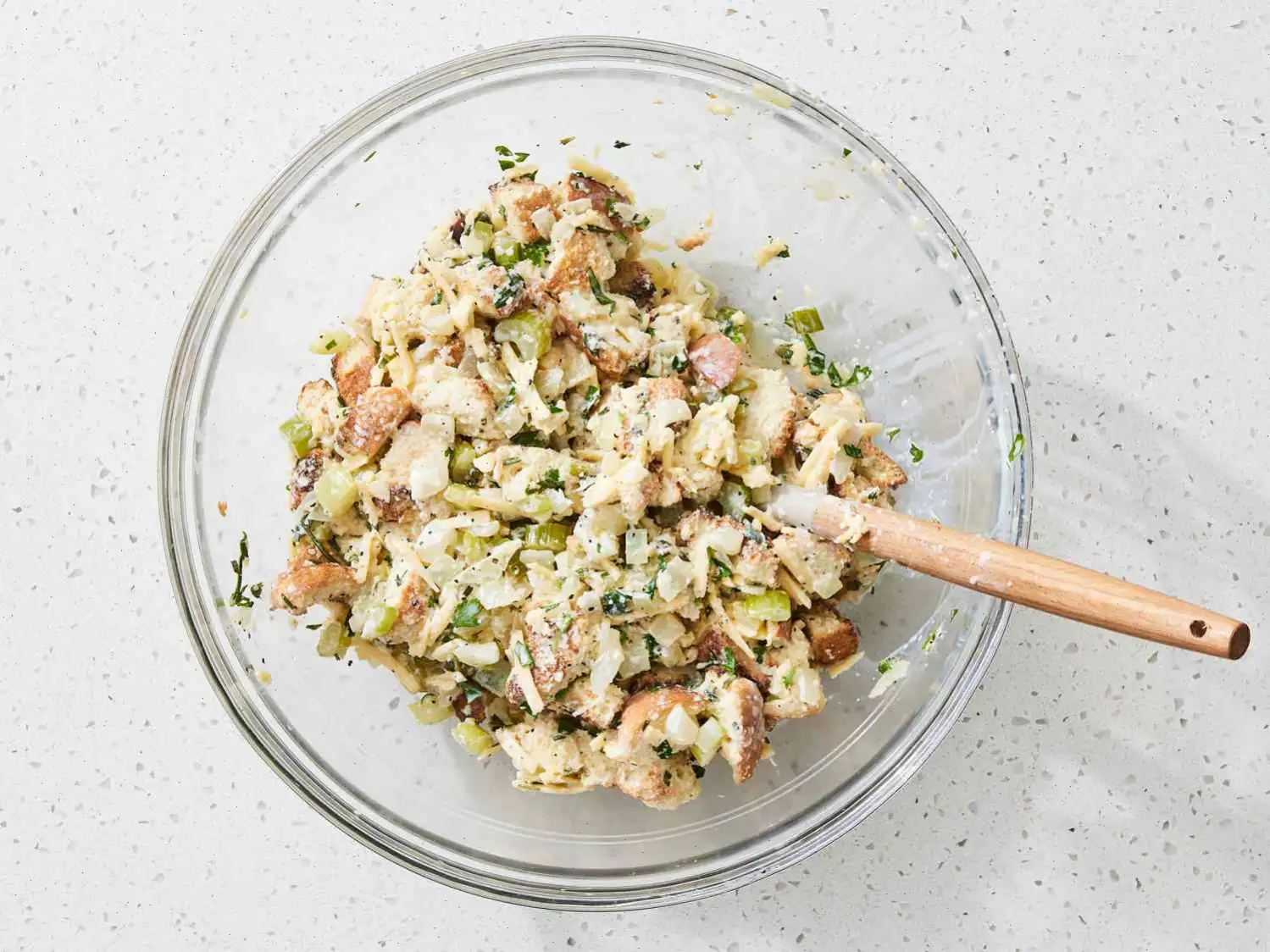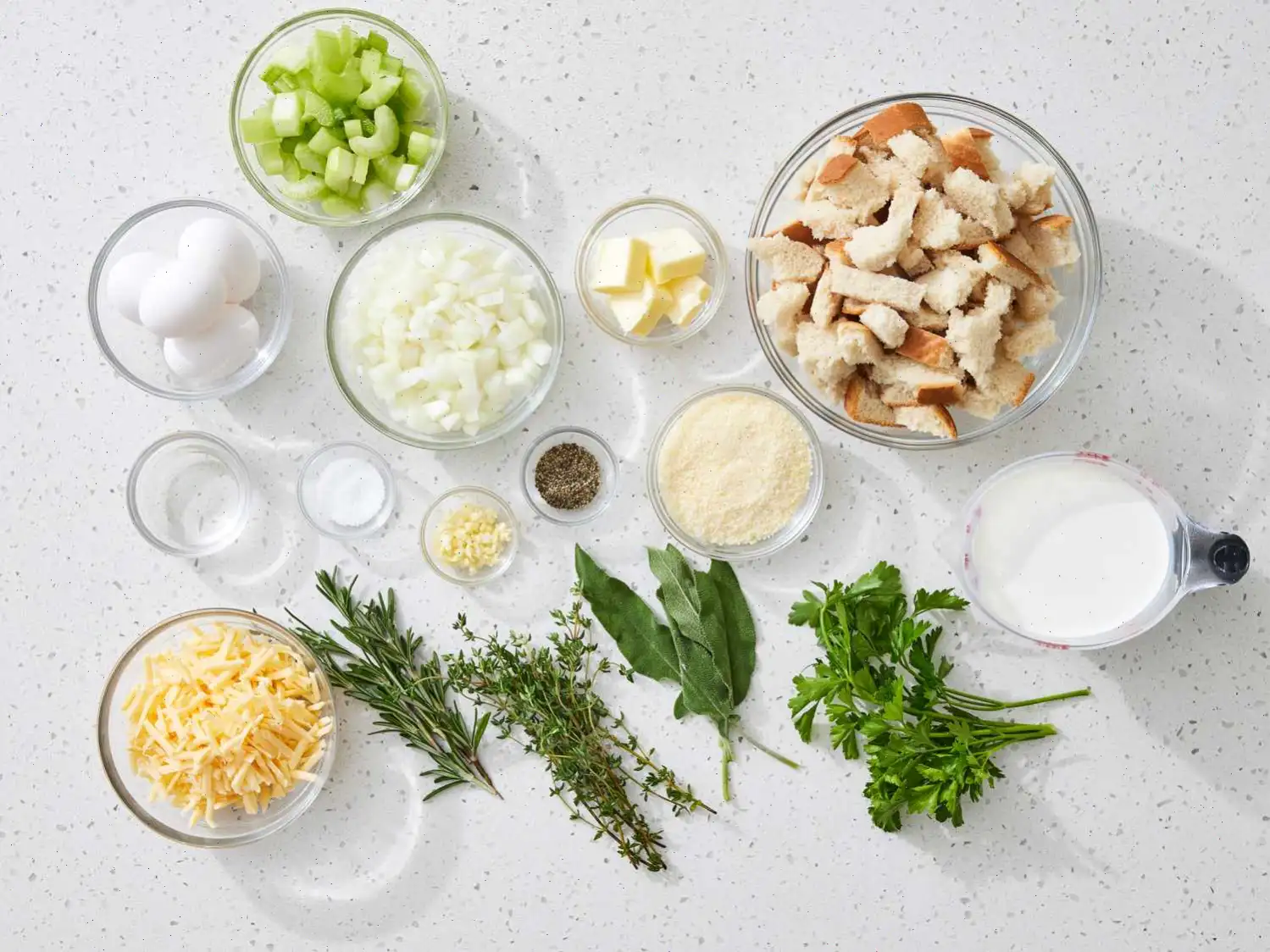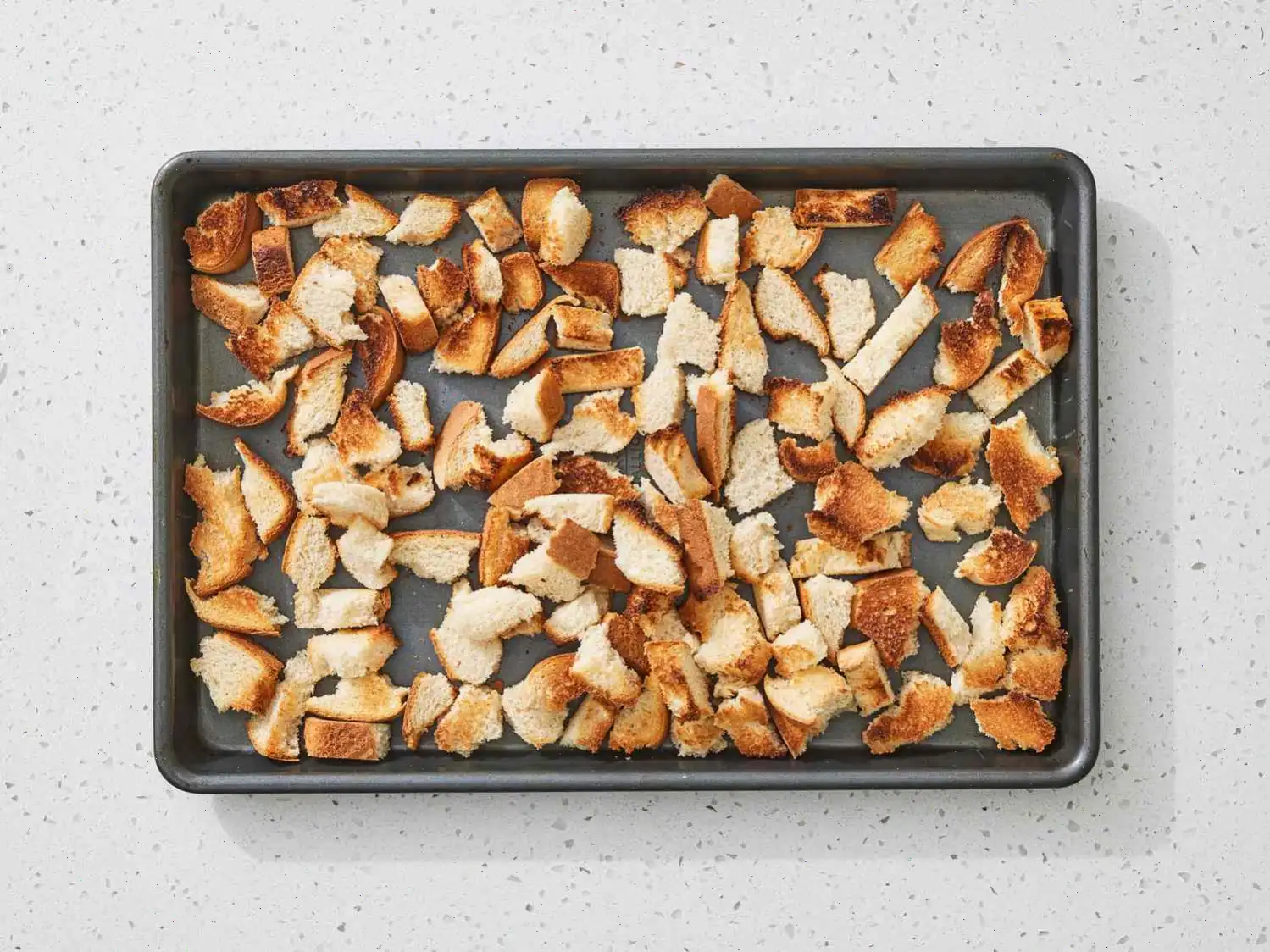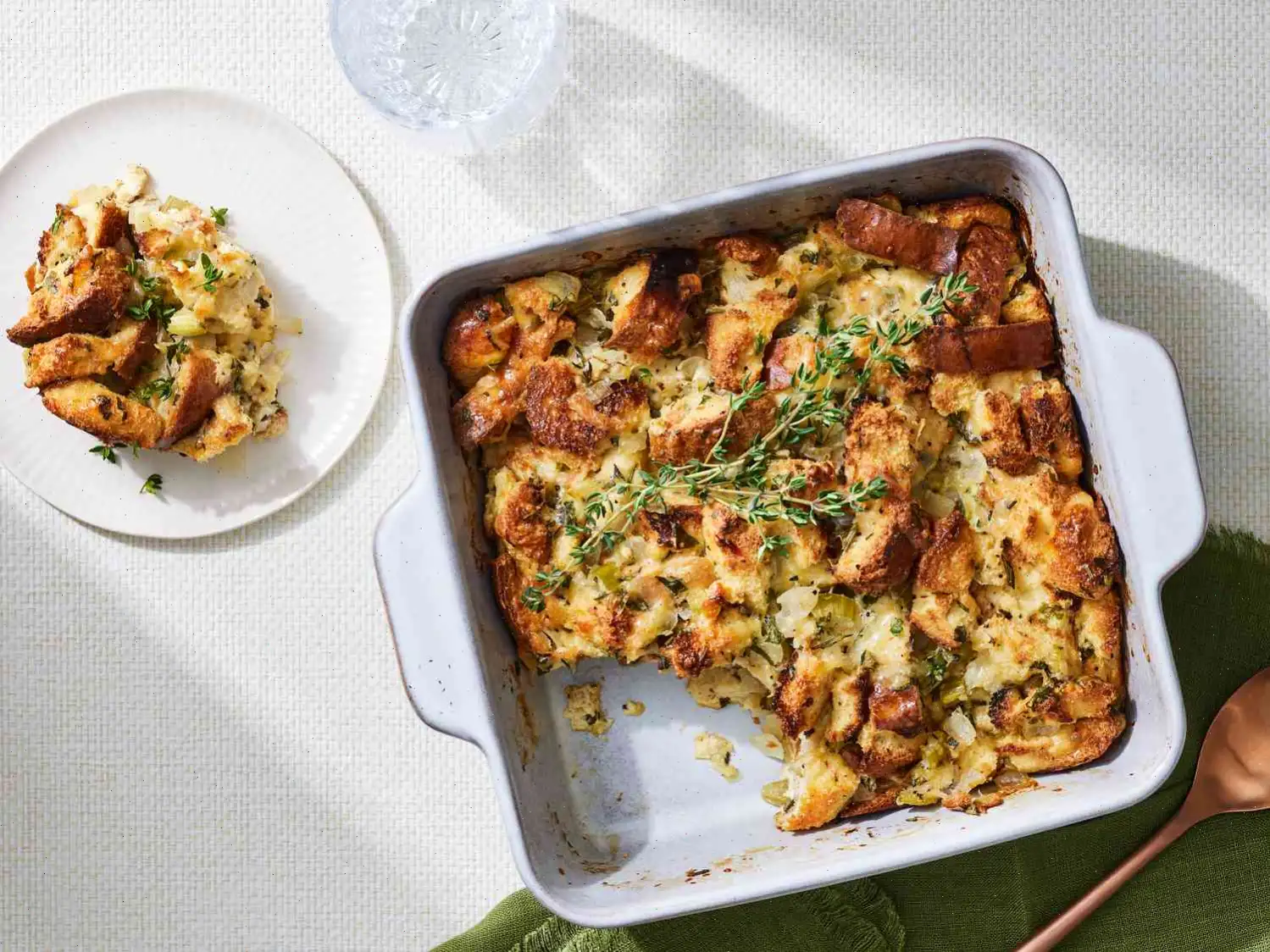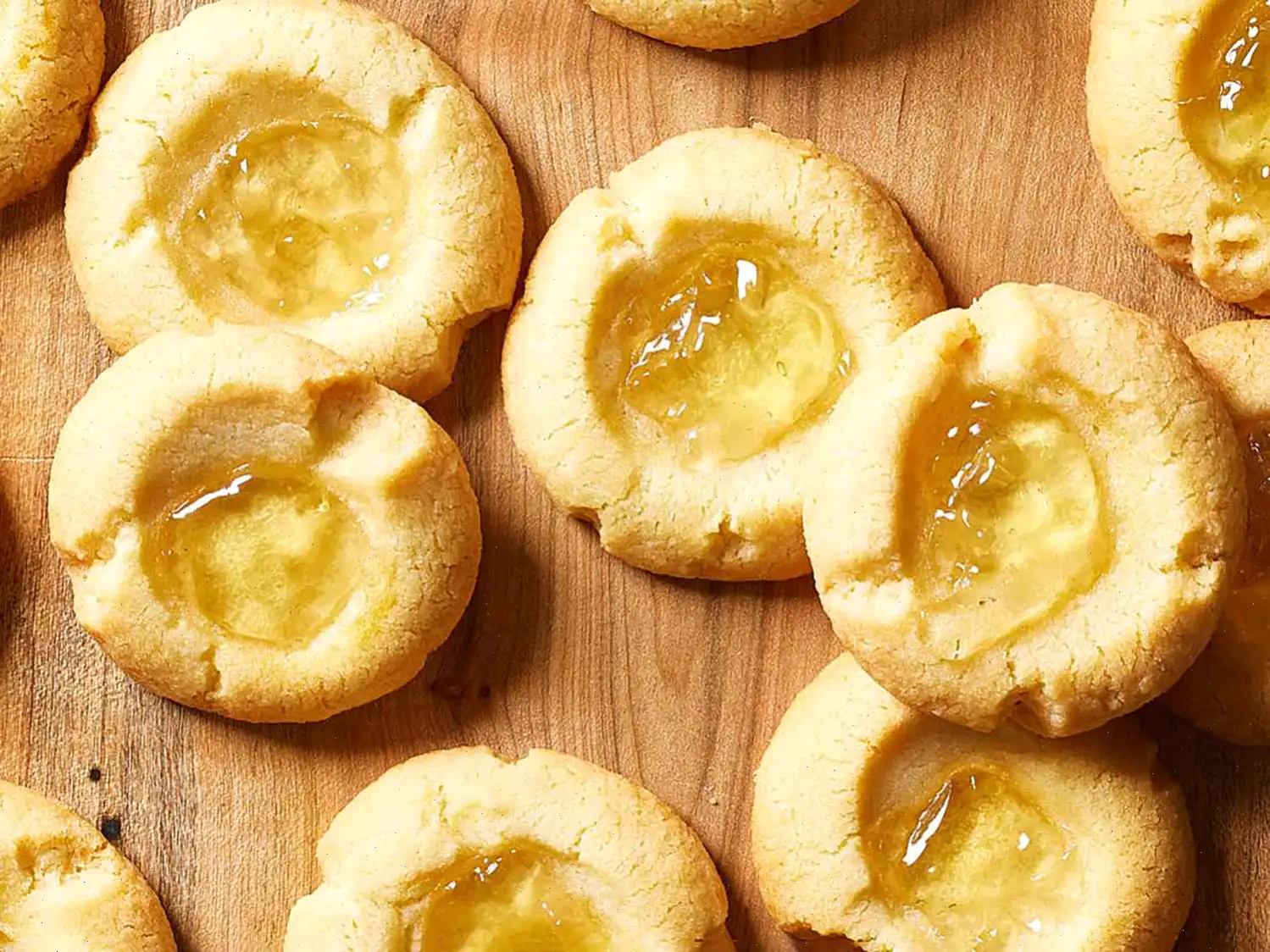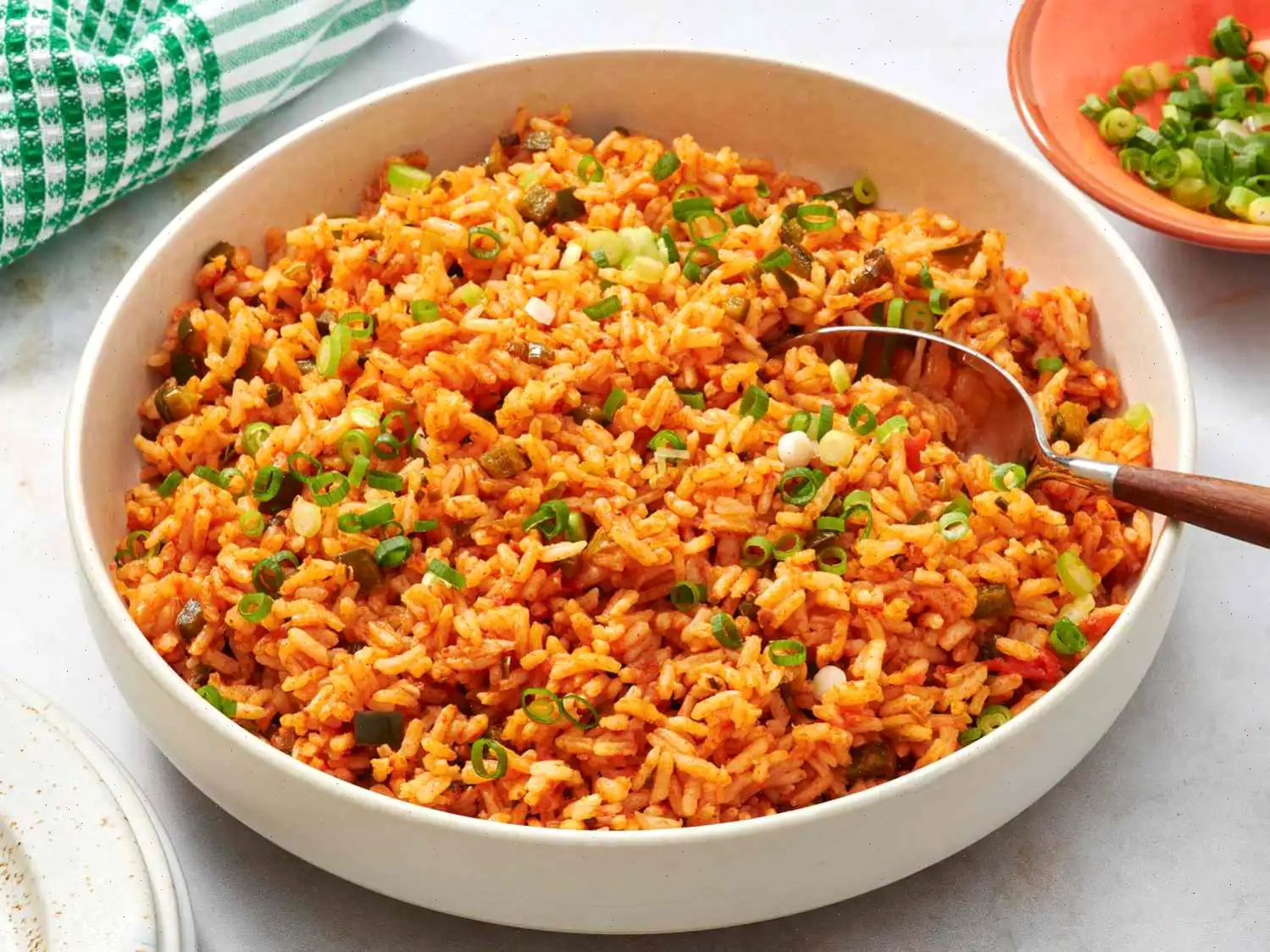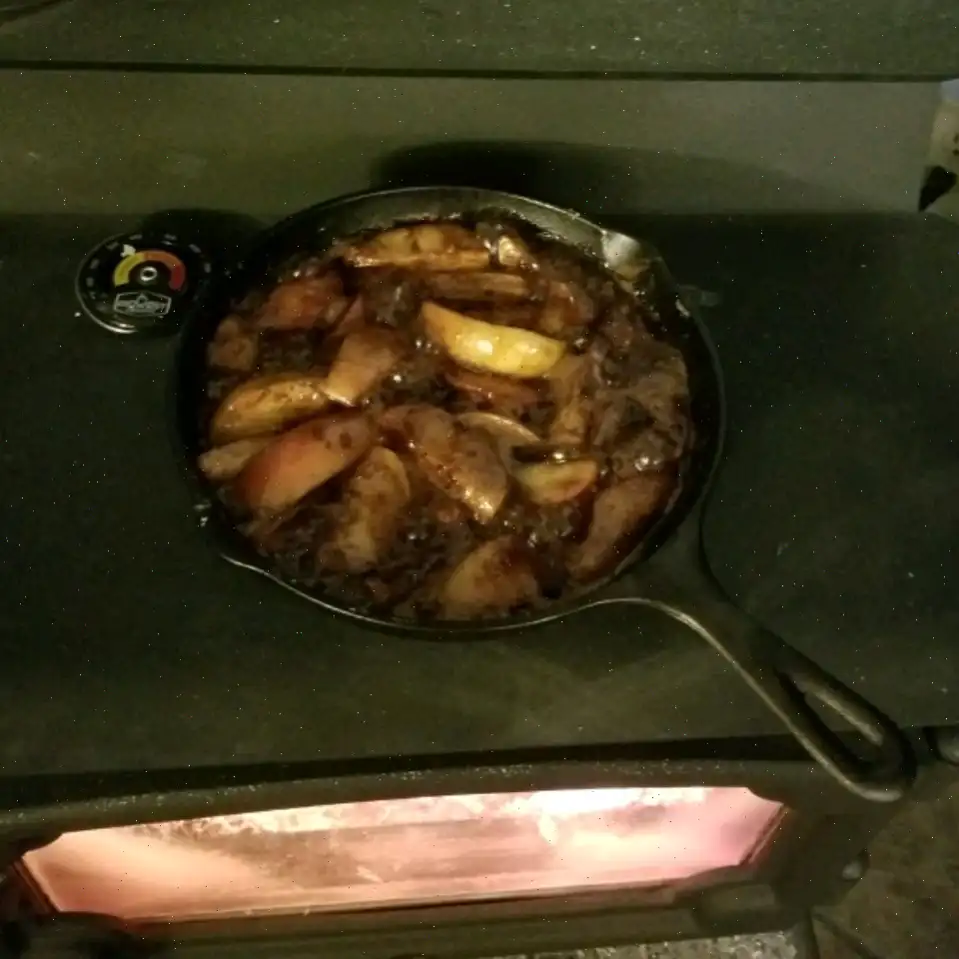
Stuffing Bread Pudding Recipe
This stuffing bread pudding is a comforting dish that captures the flavors of Thanksgiving. It combines the savory depth of stuffing with the creamy richness of bread pudding. Heres how to make this delicious meal from start to finish.
Ingredients:
- 6 cups of soft cubed sandwich bread
- 1/4 cup unsalted butter
- 1 1/2 cups chopped yellow onions (about 1 1/2 onions)
- 1 cup chopped celery
- 3 cloves garlic, minced
- 1 teaspoon dried thyme or 1 tablespoon fresh thyme
- 1 teaspoon dried sage or 1 tablespoon fresh sage
- 1 teaspoon dried rosemary or 1 tablespoon fresh rosemary
- 1 teaspoon salt
- 1 teaspoon freshly ground black pepper
- 2 tablespoons white wine vinegar
- 1/4 cup chopped fresh parsley
- 4 large eggs
- 2 cups half-and-half
- 1 cup shredded Gouda cheese
- 3/4 cup freshly grated Parmesan cheese
Directions:
Step 1: Preheat your oven to 350F (175C). Grease a 2-quart baking dish and set it aside.
Step 2: Spread the bread cubes out on a large baking sheet. Toast them in the oven for about 20 minutes, stirring halfway through. When golden and crisp, remove from the oven and set aside.
Step 3: Melt the butter in a large skillet over medium heat. Add the chopped onions and celery, stirring frequently, and cook until the onions are translucent, about 5 minutes.
Step 4: Add the minced garlic, thyme, sage, rosemary, salt, and pepper to the skillet. Continue cooking, stirring for about 2 minutes, until the garlic becomes aromatic.
Step 5: Pour in the white wine vinegar and cook for 1 more minute, scraping the bottom of the pan to lift any browned bits.
Step 6: In a large bowl, combine the toasted bread cubes, the onion-celery mixture, and the fresh parsley. Set aside.
Step 7: In a separate medium bowl, whisk together the eggs, half-and-half, shredded Gouda, and grated Parmesan cheeses.
Step 8: Pour the egg mixture into the bread mixture and stir until everything is evenly combined.
Step 9: Spread the bread pudding mixture evenly into the prepared baking dish. Cover with plastic wrap and refrigerate for at least 2 hours, or overnight for best results.
Step 10: Let the bread pudding sit at room temperature for 20 minutes before baking. Preheat the oven to 350F (175C).
Step 11: Bake for about 45 minutes, until the center is set and the top is golden brown. The internal temperature should reach 160F (71C) when measured with a thermometer. A knife inserted in the center should come out clean.
Step 12: Allow the bread pudding to stand for 10 minutes before serving.
Test Kitchen Tips:
- You can substitute white Cheddar cheese or Gruyre cheese for Gouda if you prefer.
- Both fresh and dried herbs work well. If using dried herbs, use about 1/3 the amount of fresh herbs. For example, 1 teaspoon dried thyme equals 1 tablespoon fresh thyme.
- For a heartier version, consider adding sausage crumbles to the mixture.
- To ensure food safety, casseroles containing eggs should be cooked to an internal temperature of 160F (71C) to eliminate any risk of raw egg contamination.
Nutrition Facts (per serving):
- Calories: 452
- Total Fat: 30g (38% Daily Value)
- Saturated Fat: 17g (84% Daily Value)
- Cholesterol: 199mg (66% Daily Value)
- Sodium: 954mg (41% Daily Value)
- Total Carbohydrate: 29g (11% Daily Value)
- Dietary Fiber: 2g (8% Daily Value)
- Total Sugars: 7g
- Protein: 18g (36% Daily Value)
- Vitamin C: 8mg (8% Daily Value)
- Calcium: 408mg (31% Daily Value)
- Iron: 3mg (15% Daily Value)
- Potassium: 373mg (8% Daily Value)
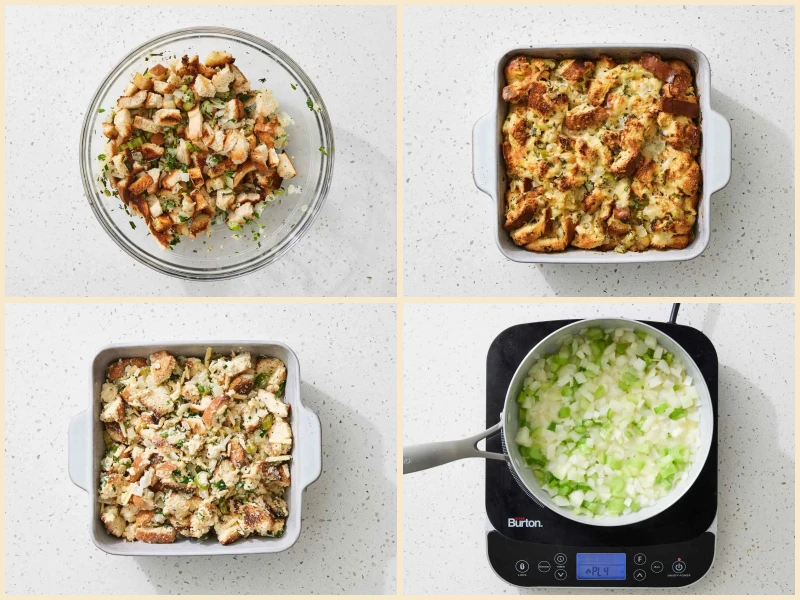
Stuffing Bread Pudding, often seen as a delightful hybrid of stuffing and bread pudding, is a cherished dish in American kitchens, particularly during the holiday season. It combines traditional stuffing ingredients with the comforting richness of a bread pudding, making it a versatile side dish for festive dinners, especially Thanksgiving.
History and Origins
Though the exact origin of stuffing bread pudding is unclear, it is believed to be a creative twist on classic stuffing, a dish with roots dating back to ancient Rome. Early stuffing recipes included bread and various herbs and vegetables, similar to todays stuffing. The addition of eggs and cream to create a pudding-like consistency is likely a more modern innovation, evolving from the concept of bread puddings that became popular in Europe during the Middle Ages. Over time, this dish found its way into American kitchens, especially as Thanksgiving traditions grew in popularity.
Regional Variations
Stuffing Bread Pudding may vary depending on the region, as many American states add their own twist to the dish. In the South, for example, you may find versions with sausage, while in the Northeast, variations often include apples or cranberries. The inclusion of different cheeses, such as Gruyre or sharp Cheddar, adds depth of flavor, and regional herbs like thyme and rosemary are used for local flair. This dish is flexible, allowing cooks to adjust the ingredients based on what's readily available or preferred in their local cuisine.
How It Differs from Similar Dishes
While it may seem similar to traditional stuffing or dressing, stuffing bread pudding differs in texture and richness. Traditional stuffing is typically drier and more granular, relying on broth or butter to moisten the bread. Bread pudding, on the other hand, is custard-like and moist, created by combining bread with eggs, milk, and often sugar. Stuffing bread pudding takes the best elements of both: the savory herbs and vegetables from stuffing combined with the creamy, soft texture of bread pudding.
Where Its Typically Served
Stuffing Bread Pudding is most commonly served as a side dish at large family gatherings, particularly during Thanksgiving and Christmas. Its rich and hearty nature makes it a perfect accompaniment to roasted turkey, ham, or even a rich prime rib roast. You may also find this dish at fall potlucks or festive dinners, as its ability to be made ahead of time and served warm makes it convenient for busy holiday cooks.
Fun Facts
- The combination of bread and eggs in the recipe can be traced back to medieval Europe, where bread pudding was a way to use up stale bread.
- Stuffing Bread Pudding is a popular dish to prepare ahead of time, as it needs time to chill in the fridge before baking, allowing the flavors to meld.
- In some variations, sausage or bacon crumbles are added to make the dish heartier, while others include sweet elements like apples or cranberries for a balance of savory and sweet flavors.
- Although commonly enjoyed in the fall, Stuffing Bread Pudding is delicious year-round, especially when paired with roast meats or even a simple green salad for a lighter meal.
FAQ about Stuffing Bread Pudding Recipe
Comments
Richard Edwards
11/30/2023 04:06:26 AM
WOW, this recipe is absolutely amazing!!!! I followed it exactly as written and wouldn't make any changes! It's simple enough to prepare ahead for a weeknight meal, yet impressive enough to serve to guests. I'm definitely including this on my Thanksgiving menu!
Emily Ramirez
12/05/2023 08:06:14 PM
After spending over 15 minutes on meal prep, which may just be due to my slow pace, I found it to be a worthwhile effort. The recipe didn't specify what to do with the garlic, so I simply peeled and roughly chopped it. Substituting Gruyere and freshly grated pecorino romano for the Gouda worked out well. I also followed the suggestion to add sausage crumbles by browning some JD breakfast sausage, draining it, and layering it into the dish for extra flavor. It's convenient that this dish can be prepared in the morning and then cooked later in the day after some time in the fridge. The stuffing browned nicely but remained moist, creating a harmonious blend of flavors without one overpowering the others. The cooking time was just right. To make it even better next time, I plan to include chopped apple for a touch of sweetness. We paired this dish with an Instant Pot pork chop and gravy recipe from this site, along with a side of baby potatoes and cooked fresh apple slices.


